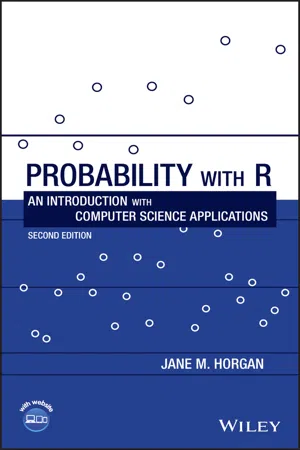
- English
- ePUB (mobile friendly)
- Available on iOS & Android
About This Book
Provides a comprehensive introduction to probability with an emphasis on computing-related applications
This self-contained new and extended edition outlines a first course in probability applied to computer-related disciplines. As in the first edition, experimentation and simulation are favoured over mathematical proofs. The freely down-loadable statistical programming language R is used throughout the text, not only as a tool for calculation and data analysis, but also to illustrate concepts of probability and to simulate distributions. The examples in Probability with R: An Introduction with Computer Science Applications, Second Edition cover a wide range of computer science applications, including: testing program performance; measuring response time and CPU time; estimating the reliability of components and systems; evaluating algorithms and queuing systems.
Chapters cover: The R language; summarizing statistical data; graphical displays; the fundamentals of probability; reliability; discrete and continuous distributions; and more.
This second edition includes:
- improved R code throughout the text, as well as new procedures, packages and interfaces;
- updated and additional examples, exercises and projects covering recent developments of computing;
- an introduction to bivariate discrete distributions together with the R functions used to handle large matrices of conditional probabilities, which are often needed in machine translation;
- an introduction to linear regression with particular emphasis on its application to machine learning using testing and training data;
- a new section on spam filtering using Bayes theorem to develop the filters;
- an extended range of Poisson applications such as network failures, website hits, virus attacks and accessing the cloud;
- use of new allocation functions in R to deal with hash table collision, server overload and the general allocation problem.
The book is supplemented with a Wiley Book Companion Site featuring data and solutions to exercises within the book.
Primarily addressed to students of computer science and related areas, Probability with R: An Introduction with Computer Science Applications, Second Edition is also an excellent text for students of engineering and the general sciences. Computing professionals who need to understand the relevance of probability in their areas of practice will find it useful.
Frequently asked questions
Information
Part I
The R Language
1
Basics of R
1.1 What Is R?
1.2 Installing R
- Go to the CRAN website at http://cran.r-project.org/;
- Choose an operating system from Linux, (Mac) OS X, and Windows appropriate to your computer. In this book, we work in the Windows environment, click “Download R for Windows”;
- Choose the “base” package;
- Click “Download R 3.6.1”, which is the current version at the time of writing.
- Press the option “Run.”
1.3 R Documentation
Table of contents
- Cover
- Table of Contents
- Preface to the Second Edition
- Preface to the First Edition
- Acknowledgments
- About the Companion Website
- Part I: The R Language
- Part II: Fundamentals of Probability
- Part III: Discrete Distributions
- Part IV: Continuous Distributions
- Part V: Tailing Off
- Appendix A: Data: Examination Results
- Appendix B: The Line of Best Fit: Coefficient Derivations
- Appendix C: Variance Derivations
- Appendix D: Binomial Approximation to the Hypergeometric
- Appendix E: Normal Tables
- Appendix F: The Inequalities of Markov and Chebyshev
- Index to R Commands
- Index
- Postface
- End User License Agreement